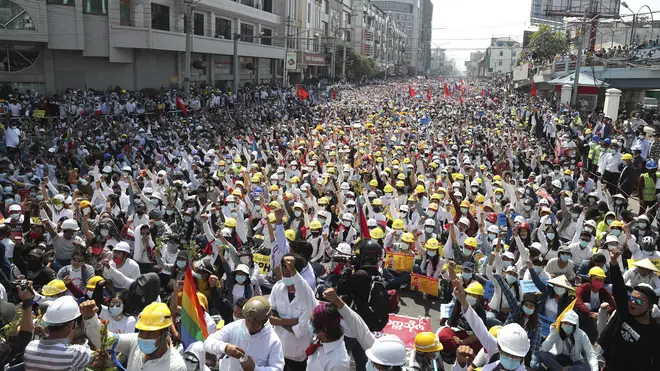
Richard Spurr 1am - 4am
22 February 2021, 10:44

Factories, workplaces and shops were closed across the country in response to the call for a nationwide strike.
Protesters have gathered in Myanmar’s biggest city despite the ruling junta’s threat to use lethal force against people who join a general strike against the military’s takeover three weeks ago.
More than 1,000 protesters gathered near the US embassy in Yangon despite barriers blocking the way, but left to avoid a confrontation after 20 military trucks with riot police arrived nearby.
Protests continued in other parts of the city, including next to Sule Pagoda, a traditional gathering point.
Factories, workplaces and shops were closed across the country on Monday in response to the call for a nationwide strike. The closures extended to the capital, Naypyitaw.

The junta had warned against a general strike in a public announcement on Sunday night on state television broadcaster MRTV.
“It is found that the protesters have raised their incitement towards riot and anarchy mob on the day of February 22. Protesters are now inciting the people, especially emotional teenagers and youths, to a confrontation path where they will suffer the loss of life,” the onscreen text said in English, replicating the spoken announcement in Burmese.
The junta’s statement also blamed criminals for past protest violence, with the result that “the security force members had to fire back”. Three protesters have been fatally shot.
Vehicles cruised the streets of Yangon on Sunday night, blaring similar warnings.

The protest movement, which seeks to restore power to the elected government of Aung San Suu Kyi and have her and other leaders released from detention, has embraced non-violence.
The nationwide strike was dubbed Five-Twos, for the five number twos in the numeric form of Monday’s date.
“I am joining the 22222 nationwide protest as a citizen of the country. We must join the protest this time without fail,” said 42-year-old Zayar, who owns a bottled water business in the capital. “So I’ve closed down my factory and joined the demonstration.”
Zin Mi Mi Aung, a 27-year-old saleswoman, also joined the strike.
“We don’t want to be governed by the regime,” she said as people marched and chanted behind her. “We will fight against them until we win.”
The United States will continue to take firm action against those who perpetrate violence against the people of Burma as they demand the restoration of their democratically elected government. We stand with the people of Burma.
— Secretary Antony Blinken (@SecBlinken) February 22, 2021
Thousands of people gathered in the capital’s wide boulevards, many on motorbikes to allow swift movement in the event of any police action.
Reports and photos of protests, some very large, in at least a dozen cities and towns were posted on social media. There were pictures of a particularly colourful event in Taunggyi, the capital of Shan State, where scores of small red hot-air balloons were set aloft. A bigger one was adorned with a drawing of the three-finger salute adopted by the anti-coup movement. The city is famous for its annual hot-air balloon festival.
In Pyinmana, a satellite town of Naypyitaw, police chased people through the streets to arrest them.
The general strike was an extension of actions called by the Civil Disobedience Movement, a loosely organised group that has been encouraging civil servants and workers at state enterprises to walk off their jobs. Many transport workers and white collar workers have responded to the appeal.
On Saturday, a General Strike Committee was formed by more than two dozen groups to provide a more formal structure for the resistance movement and launch a “spring revolution”.

The ominous signs of potential conflict drew attention outside Myanmar, with the US reiterating that it stood with the people of Myanmar, also known as Burma.
Secretary of state Antony Blinken said on Twitter the US would take firm action “against those who perpetrate violence against the people of Burma as they demand the restoration of their democratically elected government”.
“We call on the military to stop violence, release all those unjustly detained, cease attacks on journalists and activists, and respect the will of the people,” said State Department spokesman Ned Price on Twitter.
On Sunday, crowds in Naypyitaw attended a funeral for the young woman who was the first person confirmed to have been killed in the protests, while demonstrators also mourned two other protesters who were shot dead on Saturday in Mandalay, the country’s second-biggest city.
Large crowds came out again on Monday in Mandalay.

The military prevented Parliament from convening on February 1, claiming that elections last November won by Ms Suu Kyi’s party in a landslide were tainted by fraud. The election commission that affirmed the victory has since been replaced by the junta, which says a new election will be held in a year’s time.
The coup was a major setback to Myanmar’s transition to democracy after 50 years of army rule that began with a 1962 coup. Ms Suu Kyi came to power after her party won a 2015 election, but the generals retained substantial power under a military-drafted constitution.
Under the junta, 640 people have been arrested, charged or sentenced, with 593, including Ms Suu Kyi and President Win Myint, still in detention, according to the independent Assistance Association for Political Prisoners.